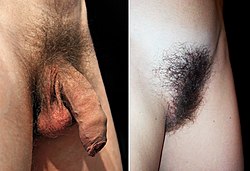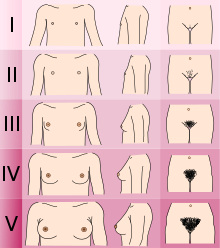Pubic hair
| Pubic hair | |
|---|---|
 Pubic hair of mature male (left) and female (right) humans | |
| Details | |
| Identifiers | |
| Latin | pubes |
| TA98 | A16.0.00.022 |
| TA2 | 7062 |
| FMA | 54319 70754, 54319 |
| Anatomical terminology | |
Pubic hair (or pubes
Although fine
Development

Pubic hair forms in response to the increasing levels of
In males, the first pubic hair appears as a few sparse hairs that are usually thin on the scrotum or at the upper base of the penis (stage 2). Within a year, hairs around the base of the penis are abundant (stage 3). Within 3 to 4 years, hair fills the pubic area (stage 4) and becomes much thicker and darker, and by 5 years extends to the near thighs and upwards on the abdomen toward the umbilicus (stage 5).[5]

Other areas of the skin are similarly, though slightly less, sensitive to androgens and androgenic hair typically appears somewhat later. In rough sequence of sensitivity to androgens and appearance of androgenic hair are the armpits (
Pubic hair and
Hair texture varies from tightly curled to entirely straight, not necessarily correlating to the texture of the scalp hair.[6][7] People of East Asian heritage tend to have black, wavy pubic hair.[8]
Pubic hair patterns can vary by
Clinical significance
Pubic lice
Pubic hair can become infested with pubic lice (also known as crab lice).
Symptoms of a crab louse infection in the pubic area is intense itching, redness and inflammation. These symptoms cause increased circulation to the skin of the pubic region creating a blood-rich environment for the crab louse. Pubic lice infestation can also be diagnosed by identifying the presence of nits or eggs on the pubic hair.[10] In December 2016 NPR reported that "Frequent removal of pubic hair is associated with an increased risk for herpes, syphilis and human papillomavirus".[13] However, the medical community has also seen a recent increase in folliculitis, or infection around the hair follicle, in women who wax or shave their bikini areas.[14] Some of these infections can develop into more serious abscesses that require incision with a scalpel, drainage of the abscess, and antibiotics. Staphylococcus aureus is the most common cause of folliculitis.[15] Burns can result when depilatory wax is used, even according to manufacturer instructions.[16]
Grooming risks
Pubic hair grooming has been associated with injury and infection. It is estimated that about 1/4 of people who groom their pubic hair have had at least one lifetime injury because of the practice.[17] Grooming has also been associated with cutaneous sexually transmitted infections, such as genital warts, syphilis, and herpes.[18]
Society and culture
According to
At puberty, many girls find the sudden sprouting of pubic hair disturbing, and sometimes as unclean, because in many cases young girls have been screened by their family and by society from the sight of pubic hair.[7] Young boys, on the other hand, tend not to be similarly disturbed by the development of their pubic hair, usually having seen body hair on their fathers.[7]
With the reintroduction of public beaches and pools, bathing in Western Europe and the Mediterranean early in the 20th century, exposure of both sexes' areas near their pubic hair became more common, and after the progressive reduction in the size of female and male swimsuits, especially since the coming into fashion and growth in popularity of the bikini after the 1940s, the practice of shaving or bikini waxing of pubic hair off the hem lines also came into vogue.[23]
Grooming practices
In some Middle Eastern societies, removal of male and female body hair has been considered proper hygiene, mandated by local customs, for many centuries.
Women working in pornography typically remove their pubic hair by shaving, a practice that became fashionable in the late 20th century. Shaving is used rather than bikini waxing because it can be performed daily, whereas waxing requires several days of growth before it can be repeated.[26] According to feminist writer Caitlin Moran, the reason for the removal of pubic hair from women in pornography was a matter of "technical considerations of cinematography".[27] Hair removal progressed to full removal.[28] Because of the popularity of pornography, pubic hair shaving was mimicked by women,[29][30] and it is among women outside the pornography industry that waxing became common in the late 20th and 21st century.[26]
The presentation is regarded by some as being erotic and aesthetic, while others consider the style as unnatural. Some people remove pubic hairs for erotic and sexual reasons or because they or their sex partner enjoy the feel of a hairless crotch.[31][32]
According to one academic study, as of 2016, approximately 50% of men in the United States practice regular pubic hair grooming, which can include trimming, shaving and removal. The study found that the prevalence of grooming decreases with age. Of males who groom pubic hair, 87% groom the hair above the penis, 66% groom the scrotum and 57% groom the penile shaft.[33]
-
Male genitalia with trimmed pubic hair
-
Male genitalia with partly shaved pubic hair
-
Fully shaved male genitalia
Methods
All hair can be removed with wax formulated for that purpose. Some individuals may remove part or all of their pubic hair, axillary hair and facial hair. Pubic hair removal using wax is called bikini waxing. The method of removing hair is called
Some women modify their pubic hair, either to fit in with societal trends or as an expression of their own style or lifestyle.[27][30] Styles of pubic hair modification include:
- Triangle or American wax (pubic hair is shortened from the sides to form a triangle so that pubic hair is hidden while wearing swimwear. The triangle can range from the very edge of the "bikini line" to up to an inch reduction on either side. Remaining hair length can be from an inch and a half to half an inch);
- Landing strip/French wax(pubic hair removed except for a strip of hair extending from the abdomen to the vulva);
- Partial Brazilian wax(pubic hair fully removed except for a small triangular strip);
- Full Brazilian waxor "sphinx" (complete removal of pubic hair); and
- Freestyle.
There are variations of the Brazilian wax in which a design is formed out of the pubic hair. Stencils for several shapes are available commercially. A controversial Gucci commercial included female pubic hair shaved into a 'G'.[38]
-
Natural or "au naturel" – no trimming and therefore no maintenance
-
Triangle/American wax" – hair shortened from the sides to form a triangle so that pubic hair is hidden while wearing swimwear
-
Landing strip/French wax – waxing with a "landing strip" or "metro ticket"
-
Partial "Brazilian wax" with a small triangular strip left
-
"Brazilian wax" or "Sphinx" – a full waxing; no hair at all
Sexual attraction
A woman or man's decision to grow or shave their pubic hair can play a role in attracting a partner. A Cosmopolitan study found that a plurality of respondents, both male and female, preferred partners who shave or at least trim their pubic hair. A smaller percentage of 6% of men and 10% of women preferred their partners to go natural and not shave or trim their pubic hair.[39]
In art
This section needs additional citations for verification. (September 2015) |

In
In 16th century southern Europe, Michelangelo showed the male David with stylized pubic hair,[43] but female bodies were depicted hairless below the head. Nevertheless, Michelangelo's male nudes on the Sistine Chapel ceiling display no pubic hair.[citation needed]
In the late 18th century, female pubic hair was openly portrayed in Japanese
L'Origine du monde (1866), by the French artist Gustave Courbet, was controversial for its realism, which pushed the limits of what was considered presentable at the time. In contrast to academic painting, which favored smooth, idealized nudes, this painting showed a close-up view of the vulva, with full pubic hair, of a woman lying on a bed with legs spread.
In history
Evidence of pubic hair removal in ancient India is thought to date back to 4000 to 3000 BC.
In Western societies, after the spread of Christianity, public exposure of a woman's bare skin between the ankle and waist started to be disapproved of culturally. Upper body exposure due to the use of the popular vest
In the 1450s, British prostitutes shaved their pubic hair for purposes of personal hygiene and the combatting of pubic lice and would don merkins (or pubic wigs) when their line of work required it.[48][49]
Among the British upper classes during the
In literature
In the erotic novel
The bush was long and thick, twisting and curling in masses half-way up to her navel, and it spread about up her buttocks, gradually getting shorter there.
In another part of his autobiography Walter remarks that he has seen those "bare of hair, those with but hairy stubble, those with bushes six inches long, covering them from bum bone to navel." And he adds reflectively – "there is not much that I have not seen, felt or tried, with respect to this supreme female article."
In like vein, in The Memoirs of Dolly Morton, an American erotic classic, the attributes of Miss Dean are noted with some surprise – her spot was covered with a "thick forest of glossy dark brown hair," with locks nearly two inches long. One man remarked:
But Gosh! I've never seen such a fleece between a woman's legs in my life. Darn me if she wouldn't have to be sheared before man could get into her.
See also
Notes
- S2CID 46057971.
- ^ Green 1998, p. 200.
- ^ "Lawrence S. Neinstein, M.D.: Adolescent Medicine – Children's Hospital Los Angeles". Archived from the original on March 7, 2016.
- ^ Rogol 2002, pp. 25–29.
- ^ Neill & Lewis 2009, p. 25.
- ^ a b c Sherrow 2006, p. 315.
- ^ a b c d Morris 2007, pp. 192–202.
- ^ Ogle & Fox 1998, pp. 52–.
- ^ a b "Pubic "Crab" Lice – Epidemiology & Risk Factors". CDC.gov. September 24, 2013. Archived from the original on December 7, 2018. Retrieved August 20, 2018.
- ^ a b c Hoffman & Williams 2012.
- ^ "Parasites – Lice". CDC.gov. September 24, 2013. Archived from the original on April 6, 2020. Retrieved August 20, 2018.
- ^ "Pubic "Crab" Lice – Biology". CDC.gov. March 17, 2015. Archived from the original on April 6, 2020. Retrieved August 20, 2018.
- ^ Doucleff, Michaeleen (December 6, 2016). "Going Bare Down There May Boost The Risk Of STDs". NPR.org. Archived from the original on April 22, 2019. Retrieved December 7, 2016.
- ISBN 9781449666156.
- ^ "Staphylococcal Infections". MedlinePlus [Internet]. Bethesda, MD: National Library of Medicine, US.
Skin infections are the most common. They can look like pimples or boils.
- PMID 21625616.
- (PDF) from the original on May 2, 2018. Retrieved May 2, 2018.
- from the original on September 20, 2019. Retrieved January 26, 2019.
- ^ Saltz, Jerry. Pudenda Agenda Archived July 1, 2004, at the Wayback Machine. artnet.com.
- ^ Weingarten & Barreca 2004, pp. 150–151.
- ^ Hilton 2002, pp. 117–120.
- ^ Batchelor 2013, p. 135.
- ^ a b Tschachler, Devine & Draxlbauer 2003, pp. 61–62.
- ^ "Waxing Unwanted Hair". Archived from the original on December 20, 2013. Retrieved March 29, 2006.
- ^ Buyukcelebi 2005, pp. 169–.
- ^ ISBN 9781317675440. Archivedfrom the original on April 17, 2023. Retrieved April 17, 2023.
- ^ a b Turner, Beverley (November 15, 2013). "Pubic hair is back". The Daily Telegraph. Archived from the original on January 11, 2022.
- ^ Friedland, Roger (June 13, 2013). "Looking Through the Bushes: The Disappearance of Pubic Hair". The Huffington Post. Archived from the original on September 22, 2017. Retrieved December 30, 2014.
- Medical Daily. Archivedfrom the original on November 5, 2019. Retrieved December 30, 2014.
- ^ a b Shire, Emily (October 4, 2014). "Waxing: Damned if You Do and Damned if You Don't: How Pubic Hair Became Political". The Daily Beast. Archived from the original on May 20, 2017. Retrieved December 30, 2014.
- ^ The Hair Down There Archived July 24, 2018, at the Wayback Machine. University of California, Santa Barbara's SexInfo. Retrieved May 4, 2007.
- PMID 27367465.
- PMID 27480727.
- ^ Speer, Richard (December 13, 2005). "The Fuzz That Was". Willamette Week. Archived from the original on August 4, 2020. Retrieved March 22, 2020.
- ^ "Belle de Jour's naughty notebook". The Telegraph. January 29, 2006. Archived from the original on November 4, 2013. Retrieved November 3, 2013.
- ^ Matisse, Mistress (August 24, 2006). "Control Tower". The Stranger. Archived from the original on September 23, 2019. Retrieved March 22, 2020.
- ^ "What Is Sugaring? Pros and Cons of This Hair Removal Option". Cleveland Clinic. June 17, 2022. Retrieved June 24, 2023.
- ^ "Tom's Pubic Ad Avoids Ban". Vogue. February 27, 2003. Retrieved October 27, 2008.
- ^ Thomson-Deveaux, Amelia (April 26, 2017). "Should I Remove My Pubic Hair – Men and Women Weigh In on Pubic Hair Removal Trends". Cosmopolitan. Archived from the original on December 16, 2021. Retrieved December 16, 2021.
- ^ Stuckey, Johanna (2007). The "Holy One" Archived January 31, 2008, at the Wayback Machine. Cross Quarterly for the Goddess Woman. 6 (4).
- ^ Barcan 2004, p. 144.
- ^ Hollander 1993, p. 136.
- ^ Kuczynski, Alex (July 16, 2015). "To Ladyscape, or Not?". Harper's BAZAAR.
- ^ Screech 1999.
- ^ Zanghellini 2009.
- ^ Masini 2005, p. 49.
- ^ Fawcett 2004, p. 195.
- ^ Oxford Companion to the Body, Oxford University Press, 2002.
- ^ Francis 2003.
- ^ a b Perrottet 2009.
References
- Green, Morris (1998). Pediatric Diagnosis: Interpretation of Symptoms and Signs in Children and Adolescents. Saunders. ISBN 978-0-7216-7284-7.
- Rogol, Alan D (2002). "Androgens and puberty". Molecular and Cellular Endocrinology. 198 (1–2): 25–29. S2CID 43444434.
- Neill, Sallie; Lewis, Fiona (2009). Ridley's The Vulva. John Wiley & Sons. ISBN 978-1-4443-1669-8.
- Sherrow, Victoria (2006). Encyclopedia of Hair: A Cultural History. Greenwood. ISBN 978-0-313-33145-9.
- ISBN 978-0099453581.
- Ogle, Robert R.; Fox, Michelle J. (1998). Atlas of Human Hair: Microscopic Characteristics. CRC Press. ISBN 978-1-4200-4836-0.
- Tschachler, Heinz; Devine, Maureen; Draxlbauer, Michael (2003). The EmBodyment of American Culture. Münster: LIT Verlag. p. 61. ISBN 978-3-8258-6762-1.
- Buyukcelebi, Ismail (2005). Living in the Shade of Islam. Tughra Books. ISBN 978-1932099218.
- ISBN 978-0-595-37466-3.
- Fawcett, F. (2004). Nâyars of Malabar. Asian Educational Services. ISBN 978-81-206-0171-0.
- Barcan, Ruth (2004). Nudity: A Cultural Anatomy. Bloomsbury Academic. ISBN 978-1-85973-872-6.
- Hollander, Anne (1993). Seeing Through Clothes. University of California Press. ISBN 978-0-520-08231-1.
- Screech, Timon (1999). Sex and the Floating World: Erotic Images in Japan, 1700–1820. Reaktion Books. ISBN 978-1-86189-030-6.
- Zanghellini, A. (2009). "Underage Sex and Romance in Japanese Homoerotic Manga and Anime". Social & Legal Studies. 18 (2): 159–177. S2CID 143779263.
- Bruce, Teresa (1996). "Pornophobia, pornophilia, and the need for a middle path". American University Journal of Gender, Social Policy & the Law. 5. Archived from the original on January 23, 2021. Retrieved September 8, 2017.
- Weingarten, Gene; Barreca, Gina (2004). I'm with Stupid: One Man. One Woman. 10,000 Years of Misunderstanding Between the Sexes Cleared Right Up. Simon and Schuster. ISBN 978-0-7432-5832-6.
- Batchelor, John (2013). John Ruskin: No Wealth But Life. Random House. ISBN 978-1-84595-215-0.
- Francis, Gareth (June 26, 2003). "A short and curly history of the merkin". The Guardian. Archived from the original on May 25, 2016. Retrieved December 16, 2016.
- Perrottet, Tony (December 14, 2009). "Secrets of the Great British Sex Clubs". Slate Magazine. Archived from the original on October 19, 2013. Retrieved September 8, 2017.
- Hoffman, Barbara L.; OCLC 779244257.











